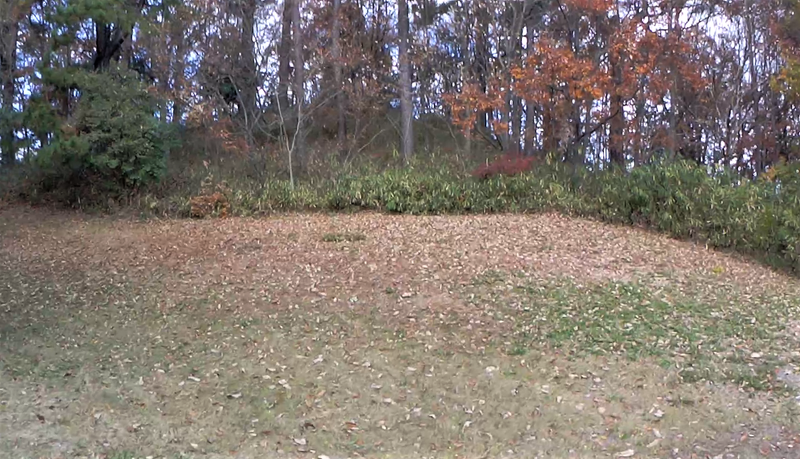(86)兵庫県加古川市にある行者塚(ぎょうじゃづか)古墳
(西条古墳群)
(86) Gyojazuka burial mound in Kakogawa City, Hyogo Prefecture
(Saijo Burial Mound Group)

行者塚(ぎょうじゃづか)古墳は加古川市住宅街の中に
史跡公園として大切に保存、公開されている。
5枚の現地説明版はとてもわかりやすく訪ねる人にはありがたい。
The Gyoja-zuka burial mound has been carefully preserved and opened to the public as a historical site park in a residential area of Kakogawa City.
The five local explanatory plates are very easy to understand and are appreciated by visitors.

囲い型埴輪と家型埴輪のセット(浄水施設を表現)
説明版を読むと、この古墳の主な特徴は三つあることがわかる。
一つは「造り出し」が異例の4つあること、そのうちの「東造り出し」と後円部の間から出土した囲い型埴輪と家型埴輪のセットが、浄水施設を表現したと想定される先駆的な発見であったこと、三つめは埋葬施設に他に例がない副葬品箱が二つあったこと。
There are three main features of this tomb, according to the explanatory plates.
The first is that there are four "tsukuridashi", and the set of enclosure-shaped haniwa and house-shaped haniwa excavated from between the "east tsukuridashi" and the rear circle is a pioneering discovery that is assumed to represent a water purification facility.

後円部
前方部
くびれ部
墳形は前方後円墳で全長約100m、後円部直径約68m・高さ9.3m、
くびれ部の幅34m(後円部径の半分)、前方部幅約55m・高さ約5m(後円部の半分)で、
全長100mクラスの前方後円墳で、後円部の直径が70m近くあることは異例であり、
後円部に対して前方部が短くて低く、なおかつ幅が広いことがこの古墳の特徴。
The shape of the mound is a forward and backward circle mound with a total length of about 100 m, a diameter of 68 m at the back of the circle and a height of 9.3 m, a width of 34 m at the neck (half of the diameter of the back of the circle), and a width of 55 m at the front and a height of 5 m (half of the back of the circle).
It is unusual for a 100-meter-long posterior frontal mound to have a diameter of nearly 70 meters, and the fact that the anterior part is shorter, lower, and wider than the posterior part is a characteristic of this mound.
各段には円筒型・朝顔型埴輪が約2500本並べられていた。
The mound is a three-tiered construction with thatched stones throughout, and each tier has about 2,500 cylindrical and morning glory-shaped clay figures.

東造り出し
造り出しは高さ1m・長さ11m・幅9m程度の台形で4つあり東・西・北東・北西にある。
後円部には幅14mの浅い堀がめぐり、その外側にも溝を巡らせていた。
There are four trapezoidal mounds with a height of 1m, a length of 11m, and a width of 9m, located in the east, west, northeast, and northwest.
A shallow moat, 14m wide, ran around the back of the circle, and a ditch ran around the outside of the moat.

金銅製虎?龍?文帯金具
後円部の埋葬施設は3基の粘土槨が見つかったが、
さらに二か所から副葬品箱がみつかり、
中から多数の鉄製品や巴形銅器、青銅製品、
中国「晋」の時代の金銅製虎文or龍文帯金具及び馬装具などが出土。
なお調査では棺まで掘り下げていない。
Three clay burial tombs were found in the rear burial chamber, and two more burial boxes were found, in which a number of iron items, Tomb-shaped bronze ware, bronze items, and gilt-bronze dragon bands and horse accessories from the Jin Dynasty were excavated. The coffin was not excavated in the survey.

築造はAC360-440ごろ(古墳時代中期)と推定
It is estimated to have been built around 360-440 AC (mid-Kofun period).
行者塚古墳発掘調査概報では
「発掘調査は開始された直後から予想をはるかにうわまわり、まさに王者の墓にふさわしいものでした。その後円部から発見された出土品は、ほとんどが舶来品で、とくに我が国最古級の金銅製帯金具の発見は驚きでした。また馬具も最古のものであることが、その後の整理研究によって明らかになりました。これは古墳に葬られた人物が、加古川地域の王としてだけでなく、大和朝廷のもとに海外交流にも活躍したことを物語っています」とのこと。
According to the Gyoja-zuka Tumulus Excavation Summary Report
According to a report on the excavation of the Gyoja-zuka burial mound, "Immediately after the excavation began, the results were far better than expected, making it a tomb fit for a king. In particular, the discovery of one of the oldest gilt bronze belt fittings in Japan was a surprise. Subsequent research revealed that the horse harness was also one of the oldest in Japan. This shows that the person buried in the burial mound was not only a king of the Kakogawa area, but was also active in overseas exchanges under the Yamato Imperial Court. The tomb is located in the center of the city.
くびれ部には階段が設置してあり登りやすい
古墳は一周回ることができ、墳頂にも登れる。
さらに「西造り出し」部分は埴輪の当時の配置が復元されている。
You can go around the tomb and climb to the top of the mound. In addition, in the west part of the tomb, the original arrangement of the clay figures has been restored.





引用/現地案内板、行者塚古墳発掘調査概報(加古川市文化財調査報告書15・全国遺跡総覧より)
Reference: Local information board, Gyoja-zuka Kofun Excavation Report (from Kakogawa City Cultural Properties Research Report 15, Zenkoku Ruins Souran)
Translation: DeepL Pro








